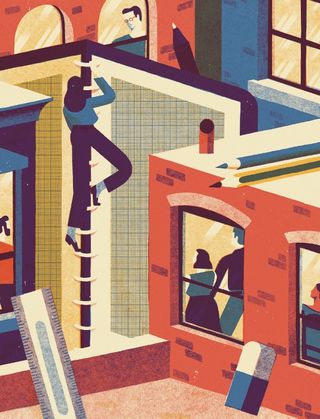Power up your portfolio
What exactly is a modern portfolio, and what do prospective employers want to see? We teamed up with the ADC to find out.

With so much advice on what to pack into your design portfolio, it's sometimes hard to know what gives you the best chance in the creative marketplace. What exactly is a modern portfolio? What goes in it? And how do you get it in front of the right people? We spoke to the Art Directors Club and its Portfolio Night judges, alongside the young designers who've benefited from such events, to find out.
Your portfolio - creatives are constantly told - is the key to unlocking industry doors. Nothing is more important or as potent for demonstrating your technical skills and creative attributes than a carefully selected body of work. So filling your portfolio with the right type of work, delivering it in the right format and getting it in front of the right people guarantees you success, right?
Not quite. The creative industries are one of the most competitive employment sectors to enter. Each year almost 200,000 creatives graduate from design colleges across the UK alone. And getting on the career ladder is just the beginning; advancing up it can be an unmerciful challenge - there are fewer executive creative directors than there are junior designers for a reason. Whether you're a design graduate taking your first tender steps in the workplace, or a midweight designer looking to progress your career, ensuring your portfolio stands out from the crowd is vital.
Creative revolution
Yet there remain questions on exactly what a modern portfolio is. So we cut to the chase and asked industry leaders what they want to see in a potential employee's folio, what format it should take and the best ways to get it in front of them.
"First and foremost [I want to see] great, original ideas that are executed well and hopefully screaming with simplicity from beginning to end," says Pierre Odendaal, chief creative officer at McCann's Johannesburg branch. "This is what creative employers seek. Young creatives' portfolios should all be about creative revolution, and not creative evolution."
Odendaal is on a mission to develop the South African creative industries, and in doing so recognises the importance of encouraging the flow of fresh talent into the sector. He helped to organise the first ADC Portfolio Night in Cape Town in 2013. An international networking, advice and recruitment event like no other, Portfolio Nights give young creatives the chance of a 15-minute direct feedback session with a global creative director. It isn't just 'speed dating for creatives', though. Portfolio Night brings together thousands of young creatives and hundreds of creative directors across dozens of host agencies in cities worldwide.
After 20 years served at a range of formidable agencies around the globe, Odendaal knows a strong folio when he sees one, and rule number one for him is ensuring the work is presented succinctly and simply.
Get the Creative Bloq Newsletter
Daily design news, reviews, how-tos and more, as picked by the editors.
"Young creatives should spend more time thinking about what they can do to their portfolios to make them more presentable and insightful. I would take the 'less is more' approach," he says.
"When a creative sells him or herself as a jack-of-all-trades who can do anything, they come across as weak and without differentiation," Odendaal continues. "Let your book speak to your strengths. Ideas, plus art direction, plus copy should be your voice."

Size matters
Format is becoming increasingly important, too. Young graduates are expected to have a digital showcase of some kind, which makes pointing quickly to your work on a phone or tablet possible - especially if you're a web or digital designer. But for networking events, interviews and meet-ups, a physical folio is still very much necessary.
As well as a considered approach to content, the size of your folio also matters. "For those who want to do the book thing, the best advice I can give is to make it A3. Don't go bigger," says Odendaal. He believes digital folios have their place - whether that's a Behance page or a bespoke site - but the same rules of selection apply. "The most important aspects of a digital portfolio are cleanliness and synchronicity," he continues. "Personally, I would make sure I've got both on hand, the digital version and the book. Some ideas come across better in one medium as opposed to others."
Blood, sweat and tears
You've carefully selected the pieces you think best demonstrate your creativity. You've added project information, case study notes and credits. You've made sure your portfolio is simple, considered and puts the work front-and-centre. So how do you get it in front of the right people?
The days of hawking your folio around every local agency are long gone. Yet the industry always needs fresh talent and new recruits - and this is where events like ADC's Portfolio Nights come in. "For the sake of our industry, we all have a responsibility to invest in the next generation of creative talent," says Brendan Watson, director of education at ADC. "It's a win-win situation. The creatives get much-needed feedback on their portfolios, which in turn makes them stronger. Therefore, the pipeline for incoming creative talent is filled with better candidates, which ultimately benefits the agencies themselves."
There are dozens of accredited portfolio nights organised all around the world. As well as ADC's Portfolio Nights, AIGA, the UK's Design Council, New Designers and D&AD New Blood, and in particular creative bodies like the Association of Illustrators and YCN, all organise and support creative portfolio events.
Once you're there in front of a globally renowned creative director, it's time to grasp your opportunity. "This is the big show. Young creatives should pour their blood, sweat and tears into their portfolio. Careers are made at Portfolio Night," says Watson.
"Getting face-to-face with today's creative leaders is invaluable," adds Helayne Spivak, director at VCU Brandcenter, one of the most revered advertising and creative postgraduate schools in the US. Spivak has not only judged on Portfolio Nights, but also has experience helping VCU students compile their portfolios to take out into the world of business. "To get real-time feedback is a golden opportunity. And if the timing is right, it's also a way to get your name out and nab your first job," she explains.
Spivak suggests opting for an element of surprise. "Imagine how many folios creative directors look through each week," she reasons. "The creative's thinking has to be so fresh, so strategically spot-on, that potential employers' heads snap back in surprise and the realisation 'I never thought of that before' goes through their minds."
To achieve this, advises Spivak, your portfolio must demonstrate variety. "Is there humour? Are there well-told stories? Is there a unique point of view? Is there long and short format? Can they make 'stuff' come to life?"
Spivak continues: "A portfolio also needs to be more interactive and personal than it's been in years past - folios are now more about getting to know someone better." One way to inject personality, she adds, might be through video: "I always like to see a short, relevant film about a student or something they believe in passionately - a documentary of a summer trip or a passion for cycling, for example. But video should be relevant and not just there for the sake of it," she warns.
A level playing field
For young creatives attending a portfolio event, the key is not to view it as a job interview - it isn't. Yes, you should be confident in your work, clear in the explanation of your critical thinking and able to engage with whoever is appraising your folio. Above all though, says Saurabh Kejriwal - an Indian designer who after attending a portfolio night in Paris was named an ADC All-Star and landed a job at BB DO Düsseldorf - it's absolutely vital to make the most of the experience.
"Opportunities in advertising and agency culture are not always a level playing field," says Kejriwal. "Events like ADC Portfolio Nights opened doors for me where there were no doors. I got face-time with very talented and experienced people, very good feedback and a lot of validation," he says. "You're not at a Portfolio Night to win or to land a job. You're there to see what the ECDs think of your work and what advice they have for you. Listen and you can gain a lot of fresh perspectives about your own ideas and creative process. And that way, you always win."

Singaporean designer Zara Kok agrees. She was working as a junior art director when she attended a local ADC portfolio night. "I walked away with helpful advice on how to continue to improve my craft - that definitely benefits your career in the long-run."
Kok suggests preparing a portfolio that showcases your ideas clearly and concisely. "You've only got a few minutes to make an impact," she reflects, "so be very selective and brutal about what you want to include."
Differentiating yourself is as much a matter of what you say as how you say it. "Bring an opinion," she urges. "I would like to think that my portfolio contained fresh ideas that made people react differently about something, and by doing so made my work memorable because it made an impact on an emotional level."
"I think the most important thing is to not worry about the outcome," adds Kejriwal. "Relax, talk clearly and have fun. People who matter will see sparks of brilliance where they exist. Those who can't, don't matter."
Words: Tom Dennis Illustrations: David Doran
This article originally appeared in Computer Arts issue 227.

Thank you for reading 5 articles this month* Join now for unlimited access
Enjoy your first month for just £1 / $1 / €1
*Read 5 free articles per month without a subscription

Join now for unlimited access
Try first month for just £1 / $1 / €1
The Creative Bloq team is made up of a group of design fans, and has changed and evolved since Creative Bloq began back in 2012. The current website team consists of eight full-time members of staff: Editor Georgia Coggan, Deputy Editor Rosie Hilder, Ecommerce Editor Beren Neale, Senior News Editor Daniel Piper, Editor, Digital Art and 3D Ian Dean, Tech Reviews Editor Erlingur Einarsson and Ecommerce Writer Beth Nicholls and Staff Writer Natalie Fear, as well as a roster of freelancers from around the world. The 3D World and ImagineFX magazine teams also pitch in, ensuring that content from 3D World and ImagineFX is represented on Creative Bloq.
